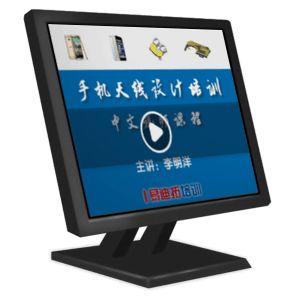- 易迪拓培训,专注于微波、射频、天线设计工程师的培养
3G iPod shuffle 拆解(英)
Apple Inc released the third-generation model of its portable music player, "iPod shuffle," March 11, 2009 (US time). To examine how Apple drastically reduced the size and weight of the iPod shuffle, Nikkei Electronics Teardown Squad purchased the new model.
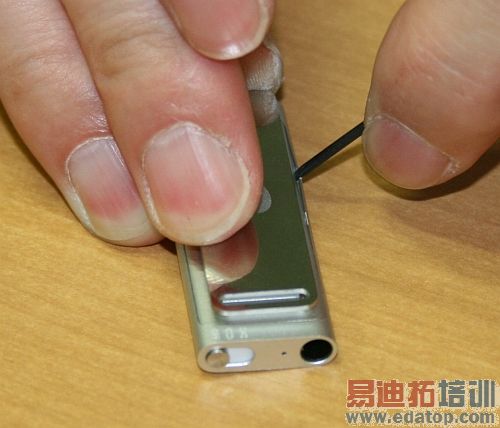
The package of the third-generation iPod shuffle
In the package, there were the main body of the iPod, a headphone with a remote control and a cable to connect the iPod to a PC via a USB interface. On the main body, we could find only a slide switch to change among the power off, in-order playback and random playback modes.
While music is being played, the remote control, which is attached to the cable for the right earphone, is used for any operation. The headphone jack not only transmits audio signals to the headphone but also serves as a terminal port for USB connection.
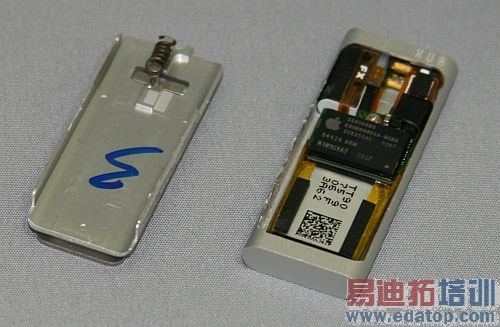
In the package, there were a cable to connect the iPod to a PC via a USB interface (left), the main body of the iPod (center) and a headphone with a remote control (right).
Much smaller, lighter
We could feel how small and light the new iPod shuffle is when we held it in hand. It’s like a small USB memory stick. Its dimensions are 45.2 (H) x 17.5 (W) x 5.3mm (D) excluding the clip (the depth is 7.8mm including the clip). And it weighs 10.7g. The dimensions and weight of the second-generation shuffle are 27.3 (H) x 41.2 (W) x 6.2mm (D) excluding the clip (the depth is 10.5mm including the clip) and 15.6g.
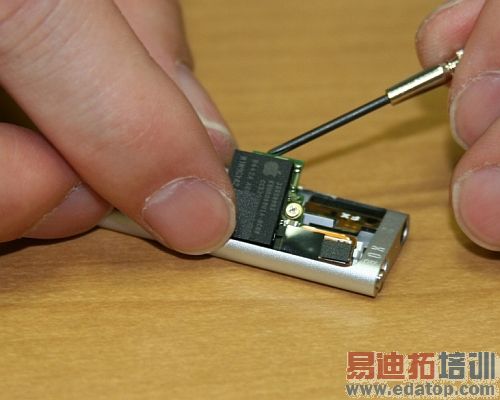
When we obtained the second-generation shuffle, we felt it was quite small. But we had the impression that the third-generation product is much smaller.
The third-generation iPod shuffle is operated mainly by the remote control attached to a cable of the headphone. When the remote control is dangling from the headphone, sound volume can be increased by pressing the upper part of the remote and decreased by pressing the lower part.
A button positioned in the center of the remote can be pressed to either play or pause music. When quickly pressed twice, it plays the next music on the list. And the triple click plays the previous music.
When the button is pressed down for a few seconds, the iPod reads out the title and artist name of music. If it is kept pressed down until it bleeps, the names of playlists begin to be read out one by one. When the button is pressed while the name of a playlist is being read out, music on the list is played.
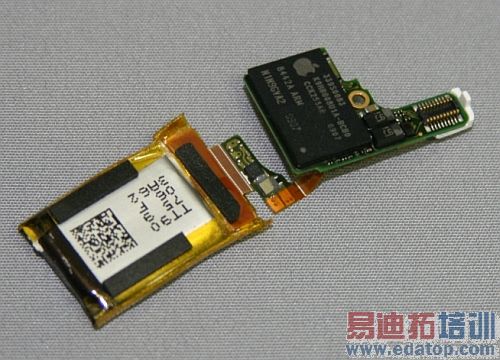
The remote control of the new iPod shuffle. The depressed area in the center can be pressed for playing back and pausing music and using the "VoiceOver" voice guidance function.
How did Apple realize the "VoiceOver" voice guidance function, which the company claims "talks to you." To use the function with the iPod shuffle, plug-in software called "VoiceOver Kit" has be added to the "iTunes," Apple’s music manager application for PCs.
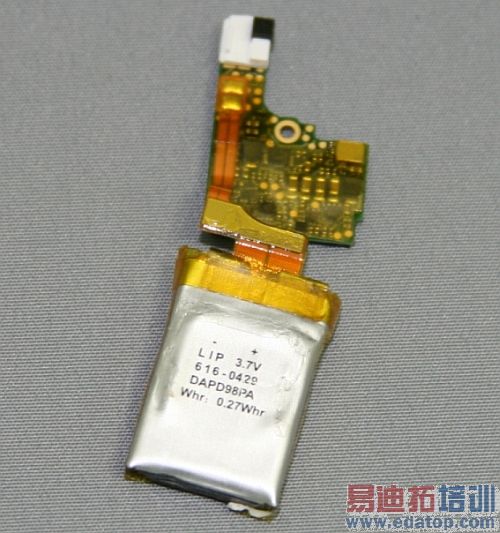
The voice guidance function becomes available by adding plug-in software called "VoiceOver Kit."
Audio data for the VoiceOver function is automatically created by VoiceOver Kit. We checked the "Tracks" folder when the iPod shuffle is connected to a PC, and found many audio files in WAV format.
When we played those audio files using a music player application on the PC, we could hear the same voice that was played by the iPod shuffle. It seems that the voice guidance function was realized by associating music, playlists and the audio files with one another and playing them in response to user operations.
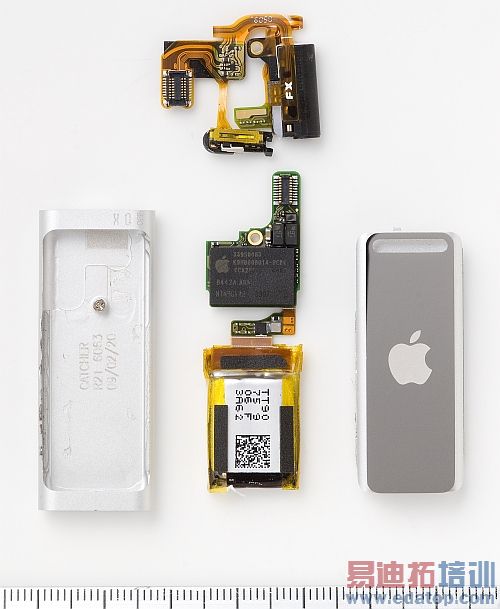
The "Playlists" folder houses playlist files, and the "Tracks" folder stores the same number of audio files (in WAV format, for the voice guidance function) as that of music files. The size of the audio file is about 100 Kbytes.
After examining the functions of the iPod shuffle, we moved on to disassemble it.
After examining the functions of the third-generation iPod shuffle, Nikkei Electronics Teardown Squad started to break it down with help from an engineer. Our goal was to know how Apple reduced the size and weight of the shuffle.
First, we began to open the chassis, but it was quite hard as in the case of the other Apple’s products. On the chassis, there is a mirrored clip. So, we tried to insert a thin metal stick into the gap between the chassis and the clip but failed several times until we finally succeeded in it.

We opened the chassis by inserting a metal stick into the gap between the clip and the chassis.
Then, we slided the stick so that the gap is widened, and pried open the chassis. The first thing that caught our eyes was a large semiconductor package with Apple’s logo. Also, we noticed that there was a secondary battery in the lower part.

After prying open the chassis, which seemed to have been cut out from aluminum metal, we found a large semiconductor package with Apple’s logo in the center of the chassis. We could not figure out the meaning of "E" mark seemingly drawn by an oil-based felt tip pen.
Next, we moved on to remove the main board. Only one screw is used to fix parts including the main board. The screw seemed to fix the board and the headphone jack to the chassis. We removed the screw and carefully took out the parts from the chassis.

Removing the parts from the chassis
The L-shaped main board removed from the chassis was about 20.7mm long and 14.2mm wide. The semiconductor package with Apple’s logo is printed with characters like "K9HB608U1A-BCBC" and "8442A ARM." The semiconductor package, which measures 8.5 x 12.5mm, occupies most of the area on the main board.
"Judging from this mark, this semiconductor must be manufactured by Samsung Electronics," the engineer said. "The second-generation iPod shuffle is also mounted with Samsung’s SoC."

One side of the main substrate is largely covered by one semiconductor package.
SoC, flash memory staked
On the back of the main board, there are a few small ICs (about 1.2 x 1.2mm in size), two crystal oscillators and some passive components such as a coil. The first- and second-generation iPod shuffles are equipped with two large ICs, which are an SoC (system on chip) and flash memory. On the other hand, the third-generation product has only one large IC. The semiconductor package with Apple’s logo seemed to contain both an SoC and flash memory.
The secondary battery is connected by a flexible substrate solder-mounted behind the main board. The battery is printed with letters such as "LIP 3.7V" and "Whr: 0.27Whr." Probably, it is a 3.7V Li-polymer secondary battery with a power capacity of 0.27Wh.

The secondary battery is connected by a flexible substrate soldered on the board.
The connector in the upper part of the main board is used to connect with the flexible substrate mounted with the headphone jack, the slide switch, etc. The second-generation iPod shuffle, too, uses a headphone jack to transmit both serial signals for the USB interface and audio signals.
"It seems like the headphone terminal was divided into four areas and is used for (1) power supply for USB, (2) grounding, (3) plus signals for USB and either one of the stereo audio signals, and (4) minus signals for USB and the other of the stereo audio signals," the engineer said. "I think the IC, which is located near the connector, is an analog switch IC to switch between USB signals and audio signals.

The components of the third-generation iPod shuffle. The main board, an Li-polymer secondary battery (center bottom) and a flexible substrate (center top) mounted with a headphone jack and a slide switch are stored in the chassis, which seems to have been cut out from aluminum metal (front side: left, back side: right).
The area of the third-generation main board is about 25% of that of the second-generation main board, which is 38.4 x 24.4 mm in size.
The area was reduced mainly by removing operation buttons such as the play/pause button and the volume control button on the main body. The main board of the second-generation iPod shuffle, which is equipped with a circular button, has five switches that receive inputs. This is the main reason for the size difference. In the second-generation product, an Li-polymer secondary battery is attached to the back of the portion with the switches.
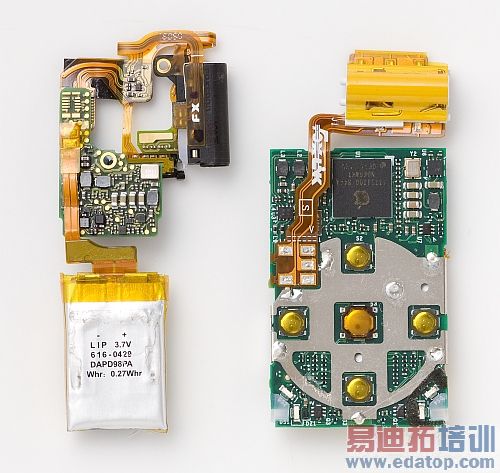
The area of the main board was cut by about 75% compared with that of the second-generation product, on which five switches are mounted.
Even compared with the main board of the second-generation product excluding the part with the five switches, the area of the new main board is about 30% smaller. This is partly because the SoC and flash memory of the new main board are placed in one location. When seen from the side, the semiconductor package looks like composed of two layers. Probably, the SoC and flash memory are stacked.
Battery capacity reduced to 2/3
The Li-polymer secondary battery of the third-generation iPod shuffle measures 16.4 x 12.8 x 3.5mm. Compared with the battery of the second-generation product, which measures 16.8 x 21.8 x 3.0mm, the battery capacity of the new product is about 2/3. So, the weight of the main body, which was reduced from 15.7 to 10.6g, was achieved by reducing the capacity of the secondary battery and the size of the chassis.

